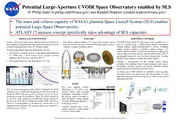
NASA Technical Reports Server (NTRS) 20160000708: Potential Large-Aperture UVOIR Space Observatory Enabled by SLS PDF
Preview NASA Technical Reports Server (NTRS) 20160000708: Potential Large-Aperture UVOIR Space Observatory Enabled by SLS
Potential Large-Aperture UVOIR Space Observatory enabled by SLS H. Philip Stahl ([email protected]) and Randall Hopkins ([email protected]) • The mass and volume capacity of NASA’s planned Space Launch System (SLS) enables potential Large Space Observatories. • ATLAST-12 mission concept specifically takes advantage of SLS capacities. SPACE LAUNCH SYSTEM VOLUME POINTING CONTROL Launch vehicle mass and volume capacity drives cost because of SLS volume capacity enables a 12.5 meter class primary mirror ATLAST-12 body points the observatory with a stability of < 1 the complexity of engineering a large space telescope to fit inside using an architecture with fold-forward/fold-aft petals around a mas for a period of up to 3000 minutes without interruption. a 5-meter fairing envelope with a 6.5 mt mass budget. central 6 to 8 meter monolithic mirror. Pointing stability enables exoplanet and UV science. Exoplanet science requires stability to minimize contrast leakage. UV SLS mass and volume capacities mitigate this cost risk: science requires stability to maximize throughput by placing the • ATLAST-12 is designed to fit in an SLS Block-IIB (scheduled science object of interest directly onto the entrance slit of the UV for 2028) with a 10-m fairing (9.1-m dynamic envelop spectrograph without the need of a fine steering mirror. Pointing diameter) and 45 mt mass capacity to SE-L2. duration is also required to enable faint object science. • 40% margin allows for ‘dry’ payload mass of 27 mt. Pointing is accomplished via the attitude control system, including: Fine Guidance Sensor; coarse pointing system (gyros, star-trackers, reaction wheels); and Active Vibration Isolation system between the spacecraft and observatory. To enable up to 3000 minutes of continuous observing time, ATLAST-12 uses solar panels with solar pressure kites on 10 m deployable booms to balance solar pressure exerted on the scarfed telescope baffle tube. MASS SLS mass capacity enables SLS is a phased development effort. Block I (scheduled for 2018) fabricating a 12.5-meter class will have a 5-m ‘commercial’ fairing and provide 25 mt to SE-L2. primary mirror using existing Block IB (2024) will have an 8.4-m diameter 19-m tall ‘short’ technology. Allocating 12-mt to fairing and provide 35 mt to SE-L2. Block II (2026) will have an the primary mirror assembly is 8.4-m 27-m ‘long’ fairing and an additional booster segment to only 100 kg/m2. Using existing provide ~45 mt to SE-L2. Finally, Block IIB (2028) will have a 65 kg/m2 technology, produces a 10-m x 31-m fairing which can be delivered ~ 45 mt to SE-L2. A 8-mt primary mirror. planned advanced booster and composite fairing are expected to Analysis indicates that a 4-mt raise this mass to ~55 mt. support structure is stiff enough to survive launch loads. This document is not subject to the controls of the International Traffic in Arms Regulations (ITAR) or the Export Administration Regulations
